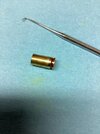CQB45ACP
Member
I showed a picture of and mentioned this yesterday in the “What have you done” thread but wanted to start it’s own thread because it’s been eating at me.
Anyway, as I’m decapping & sizing cases, I found the pictured case when it wouldn’t drop in the gauge. I don’t recall feeling anything out of the ordinary while sizing. I certainly didn’t notice anything when I shot it on Friday. Seems like, but for the gauge, I wouldn’t have found it until I was priming for another reloading.
I have many questions (mostly second guessing myself) such as what did I miss BEFORE I loaded this case? I’ve looked at many past threads on case head separation with the overwhelming number being about rifle, not handgun.
I used the pictured pick inside this and other cases without any indications of incipient separation. (First use on “incipient“ in a sentence in my life.)
Thoughts and comments welcome.

Anyway, as I’m decapping & sizing cases, I found the pictured case when it wouldn’t drop in the gauge. I don’t recall feeling anything out of the ordinary while sizing. I certainly didn’t notice anything when I shot it on Friday. Seems like, but for the gauge, I wouldn’t have found it until I was priming for another reloading.
I have many questions (mostly second guessing myself) such as what did I miss BEFORE I loaded this case? I’ve looked at many past threads on case head separation with the overwhelming number being about rifle, not handgun.
I used the pictured pick inside this and other cases without any indications of incipient separation. (First use on “incipient“ in a sentence in my life.)
Thoughts and comments welcome.


